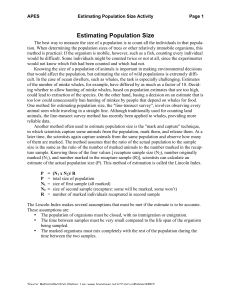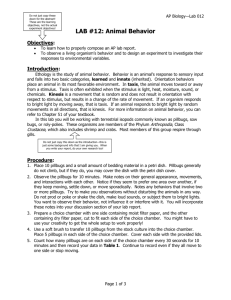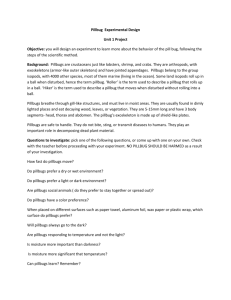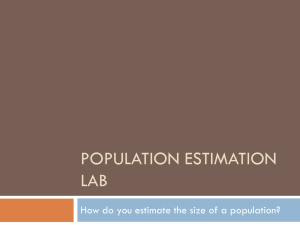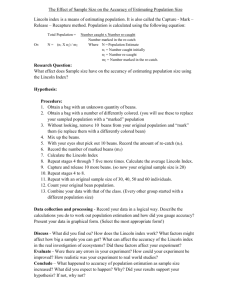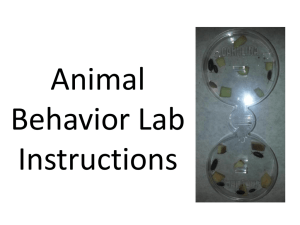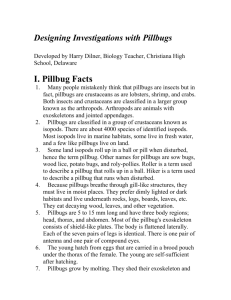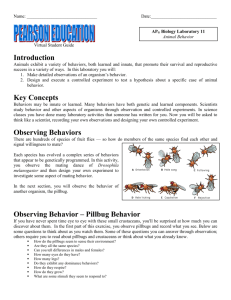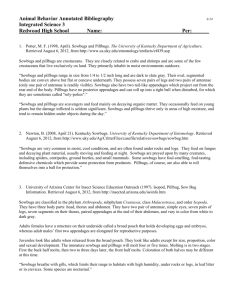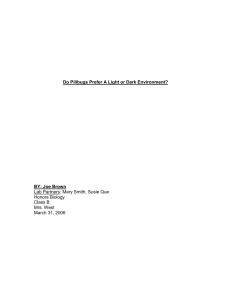Estimating Population Size
advertisement
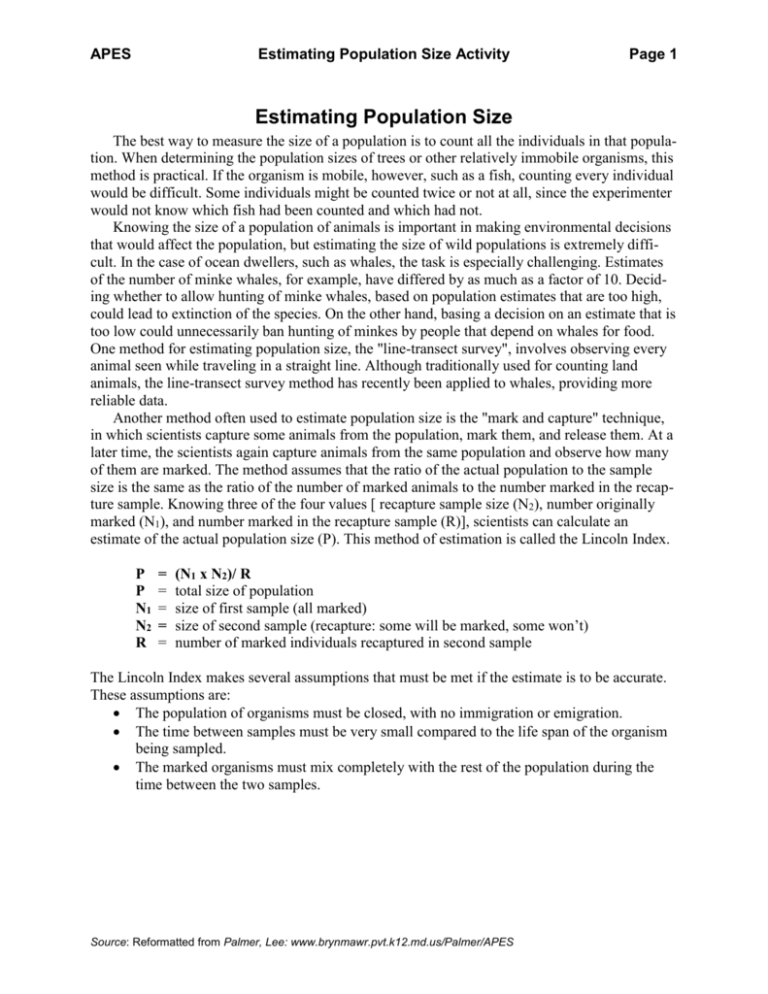
APES Estimating Population Size Activity Page 1 Estimating Population Size The best way to measure the size of a population is to count all the individuals in that population. When determining the population sizes of trees or other relatively immobile organisms, this method is practical. If the organism is mobile, however, such as a fish, counting every individual would be difficult. Some individuals might be counted twice or not at all, since the experimenter would not know which fish had been counted and which had not. Knowing the size of a population of animals is important in making environmental decisions that would affect the population, but estimating the size of wild populations is extremely difficult. In the case of ocean dwellers, such as whales, the task is especially challenging. Estimates of the number of minke whales, for example, have differed by as much as a factor of 10. Deciding whether to allow hunting of minke whales, based on population estimates that are too high, could lead to extinction of the species. On the other hand, basing a decision on an estimate that is too low could unnecessarily ban hunting of minkes by people that depend on whales for food. One method for estimating population size, the "line-transect survey", involves observing every animal seen while traveling in a straight line. Although traditionally used for counting land animals, the line-transect survey method has recently been applied to whales, providing more reliable data. Another method often used to estimate population size is the "mark and capture" technique, in which scientists capture some animals from the population, mark them, and release them. At a later time, the scientists again capture animals from the same population and observe how many of them are marked. The method assumes that the ratio of the actual population to the sample size is the same as the ratio of the number of marked animals to the number marked in the recapture sample. Knowing three of the four values [ recapture sample size (N2), number originally marked (N1), and number marked in the recapture sample (R)], scientists can calculate an estimate of the actual population size (P). This method of estimation is called the Lincoln Index. P P N1 N2 R = = = = = (N1 x N2)/ R total size of population size of first sample (all marked) size of second sample (recapture: some will be marked, some won’t) number of marked individuals recaptured in second sample The Lincoln Index makes several assumptions that must be met if the estimate is to be accurate. These assumptions are: The population of organisms must be closed, with no immigration or emigration. The time between samples must be very small compared to the life span of the organism being sampled. The marked organisms must mix completely with the rest of the population during the time between the two samples. Source: Reformatted from Palmer, Lee: www.brynmawr.pvt.k12.md.us/Palmer/APES APES Estimating Population Size Activity Page 2 PART A: IN-CLASS ACTIVITY - BEANS Simulate the mark and capture method using beans. MATERIALS: 50 beans, marking pen, plastic container with lid PROCEDURE: 1) Mark 20 of the beans with the marker. 2) Place all 50 beans in the container and cover with the lid. Shake the container to mix the marbles thoroughly. Take the lid off and without looking, withdraw 10 beans. Count the number of marked beans and record in the data table. 3) Put the 10 beans back in the container and replace the lid. Shake the container again and withdraw a second set of beans. Again, record the number of marked beans in the sample in the data table. Continue in this manner until you have completed 10 trials. 4) Estimate the population size for each trail by multiplying the number of beans marked (20) by the number of beans in each sample (10) and dividing the product by the number of marked beans for that trial. The result is an estimation of population size. When you have done this for all 10 trials, find the average by adding the estimates and dividing by 10. DATA: Trial # marked beans # in sample population estimate 1 2 3 4 5 6 7 8 9 10 Average population size estimate: ______________ ANALYSIS: 1) How does the average value compare to the actual population size of 50? 2) If there is a difference, explain what might cause the difference. 3) What problems might scientists encounter in using this method in the field that you would not have encountered in the simulation? Source: Reformatted from Palmer, Lee: www.brynmawr.pvt.k12.md.us/Palmer/APES APES Estimating Population Size Activity Page 3 PART B: FIELD ACTIVITY - PILL BUGS PURPOSE: To use the mark and capture method to estimate the size of a population of pillbugs. (See appendix for pillbug biology.) MATERIALS: model paint or opaque nail polish fine brush magnifier meter stick or tape 2 collecting jars or plastic boxes old boards, bricks, or stones PROCEDURE: 1) Select an area where the ground is slightly damp and where there is cover, such as stones, leaves, branches, or litter. It is desirable, but not necessary, for the area to be surrounded by a drier area. Use the meter stick or tape to measure the dimensions of the area and estimate its total area in square meters. 2) Look under the cover and on the surface of the ground for pillbugs. Collect 30-50 and put them in one collection jar. If you have trouble finding pillbugs, you can set bricks or boards on the ground overnight. The next day you should be able to find pillbugs under them. 3) Mark the top of each pillbug with a small spot of paint or nail polish. Allow the paint to dry and place the marked pillbugs in the second jar. When all of the pillbugs are marked, release them into the area. 4) Return to the area every day for a week and capture a sample of pillbugs. Count the number of marked pillbugs in your samples and record the data in your notebook. Be sure to release your captured pillbugs each time. 5) Estimate the population size from each day’s data by multiplying the number of pillbugs you marked by the number of pillbugs in each sample. Divide the product by the number of marked pillbugs in the sample. After finding the population estimates for each day, find the average estimate by adding up the daily estimates and dividing by the number of samples. Source: Reformatted from Palmer, Lee: www.brynmawr.pvt.k12.md.us/Palmer/APES APES Estimating Population Size Activity Page 4 DATA: Number of pillbugs in first sample (marked): _______ DATE # pillbugs captured # marked pillbugs population size estimate Average population size estimate: ______________ ANALYSIS: 1) What is the range of population estimates (highest - lowest)? Is there a trend in the variation of estimates (for example, do the estimates decrease steadily each day, remain the same, or increase and decrease alternately)? What might explain finding different population estimates? 2) Are the assumptions required for the mark and capture method valid for your observations? Why or why not? Why are these assumptions necessary? 3) Using the average estimate of population size and the area of study, calculate the density of pillbugs (number of pillbugs per square meter). APPENDIX: Pillbug Biology Pillbugs belong to the phylum Arthropoda, which includes insects, arachnids (spiders, mites), millipedes, centipedes, and crustacea. All of these have an outer skeleton, jointed appendages, and segmented bodies. Crustacea are a large and varied class of arthropods - its most prominent members being shrimps, crabs, and lobsters - distinguished from other arthropods by having two pairs of antennae. Pillbugs and sowbugs are terrestrial members of the crustacean group known as isopods, most of whose 4,000 species live in water. Pillbugs and sowbugs have a small head with one pair of large antennae and a second much smaller pair. Behind the head are 7 large (thoracic) segments and 6 smaller (abdominal) segments. Each thoracic segment has a pair of walking legs, and each abdominal segment has a pair of smaller appendages. Pillbugs have an arched back and roll up into a ball when disturbed. Sowbugs are flatter and move away from a disturbance. The pillbug diet, which is extremely varied, includes fruit, young plants, fungi, decaying matter, and their own feces. The latter habit is related to their need for copper for the oxygencarrying blood chemical hemocyanin, (as we need iron for our hemoglobin). Pillbug predators include birds, amphibians, mites, spiders, and centipedes. Although pillbugs secrete noxious chemicals from glands along the thorax, their most effective defense is their tendency to seek dark, sheltered places. Source: Reformatted from Palmer, Lee: www.brynmawr.pvt.k12.md.us/Palmer/APES
